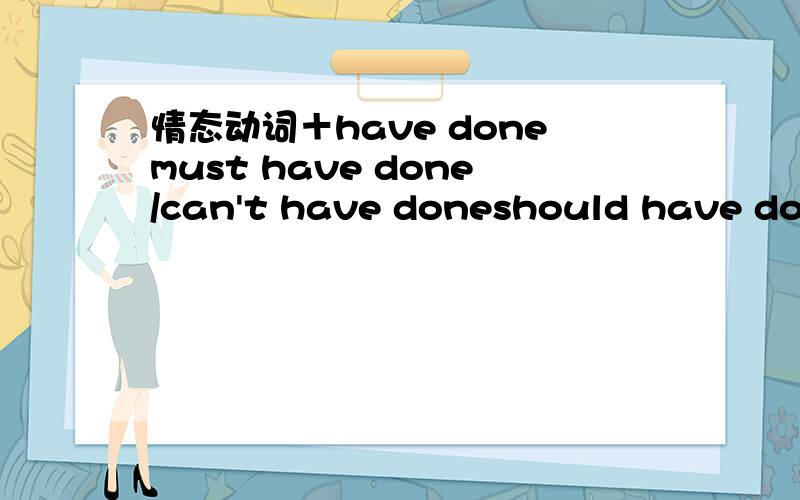情态动词+have donemust have done/can't have doneshould have done/shouldn't have doneneed have done/needn't have donemay(might) have done/haven't donecould have done/couldn't have donewould have done/wouldn't have done如何用?我这样分正
来源:学生作业帮助网 编辑:作业帮 时间:2024/04/29 13:46:47

情态动词+have donemust have done/can't have doneshould have done/shouldn't have doneneed have done/needn't have donemay(might) have done/haven't donecould have done/couldn't have donewould have done/wouldn't have done如何用?我这样分正
情态动词+have done
must have done/can't have done
should have done/shouldn't have done
need have done/needn't have done
may(might) have done/haven't done
could have done/couldn't have done
would have done/wouldn't have done
如何用?我这样分正确吗?
有 might not /may not +have done
would/wouldn't have done
情态动词+have donemust have done/can't have doneshould have done/shouldn't have doneneed have done/needn't have donemay(might) have done/haven't donecould have done/couldn't have donewould have done/wouldn't have done如何用?我这样分正
情态动词+ have done都是表示对过去动作的推测
must have done 过去一定做了某事
should /need have done 本来应该/需要做某事(却没做)
should't/needn't have done本来不应该/不需要做某事(却做了)
may/might have done 过去可能做过某事
could have done过去有能力做某事
含有情态动词的肯定/否定被动语态,都是现在完成时哦!
这些其实都是对过去的虚拟表达。
must have done/can't have done表示一定做过,不可能做过(这是对过去的猜测,否定只能用can't)He must have come here. 他一定来过这里。
should have done/shouldn't have done 本应该做或不做什么;
need have done/needn't have ...
全部展开
这些其实都是对过去的虚拟表达。
must have done/can't have done表示一定做过,不可能做过(这是对过去的猜测,否定只能用can't)He must have come here. 他一定来过这里。
should have done/shouldn't have done 本应该做或不做什么;
need have done/needn't have done本需要做或本不必做什么
could have done可能做过...(猜测的语气比may强些)
may(might) have done 或许做过...(猜测的语气最弱)
收起
1“can(could) + have + 过去分词”的疑问或否定形式表示对过去发生的行为怀疑或不肯定。如:
He cannot have been to that town.
Can he have got the book?
2“may(might) + have + 过去分词”表示对过去发生的行为的推测。如:
He may not have finis...
全部展开
1“can(could) + have + 过去分词”的疑问或否定形式表示对过去发生的行为怀疑或不肯定。如:
He cannot have been to that town.
Can he have got the book?
2“may(might) + have + 过去分词”表示对过去发生的行为的推测。如:
He may not have finished the work.
3“must + have + 过去分词”的结构常用在肯定句中,表示对过去发生的行为的推测。它的否定或疑问式用can代替must。
He must have been to Shanghai.
4 need表示“需要”或“必须”,作情态动词时,仅用于否定句或疑问句中,在肯定句中一般用must, have to, ought to,或should代替。如:
You needn’t come so early.
— Need I finish the work today?
— Yes, you must.
注意:needn't + 不定式的完成式“表示本来不必做某事而实际上做了某事”。如:
You needn't have waited for me. “should + have + 过去分词”结构一般表示义务,表示应该做到而实际上没有做到,并包含一种埋怨、责备的口气。如: She should have finished it.
I should have helped her, but I never could.
You should have started earlier.
收起